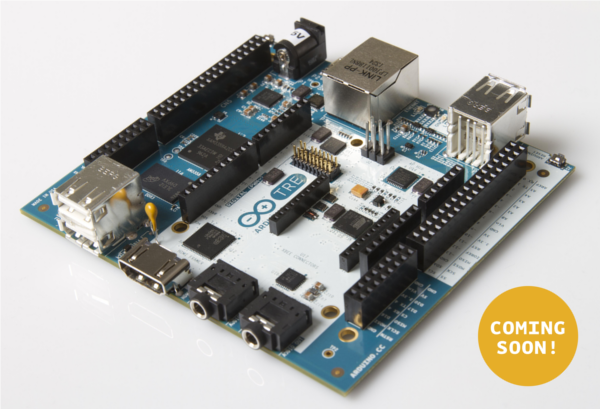Arduino TRE, the first Arduino board manufactured in the U.S. Thanks to the 1-GHz Sitara AM335x processor, Arduino developers get up to 100 times more performance with the Sitara-processor-based TRE than they do on the Arduino Leonardo or Uno. This performance opens the doors to more advanced Linux-powered applications. The Sitara-processor-based Linux Arduino can run high-performance desktop applications, processing-intensive algorithms or high-speed communications.
The Arduino TRE is a Sitara-processor-based Linux Arduino plus a full AVR-based Arduino, while leveraging the simplicity of the Arduino software experience. The integration of the AVR Arduino enables the Arduino TRE to use the existing shield ecosystem so that innovators can expand the Arduino TRE to develop a wide range of high-performance applications such as 3D printers, gateways for building automation and lighting automation, telemetry hubs that collect data from nearby sensors wirelessly, and other connected applications that require host control plus real-time operations.
In addition, the Arduino TRE is partially the result of a close collaboration between Arduino and the BeagleBoard.org foundation. These open hardware pioneers share a passion for expanding open source development and making technology accessible for artists, designers and hobbyists. The TRE design builds upon the experience of both Arduino and BeagleBoard.org, combining the benefits of both community based boards.
The Arduino TRE Developer Edition is currently available on our store in a limited batch. The Arduino TRE final board will be available later this year, pending results of Beta Testing Program
- Microcontroller Atmel ATmega32u4
- Clock Speed 16 MHz
- Flash Memory 32 KB (ATmega32u4)
- SRAM 2.5 KB (ATmega32u4)
- EEPROM 1 KB (ATmega32u4)
- Digital I/O Pins (5V logic) 14
- PWM Channels (5V logic) 7
- Analog Input Channels 6 (plus 6 multiplexed on 6 digital pins)
- Processor Texas Instrument Sitara AM3359AZCZ100 (ARM Cortex-A8)
- Clock Speed 1 GHz
- SRAM DDR3L 512 MB RAM
- Networking Ethernet 10/100
- USB port 1 USB 2.0 device port, 4 USB 2.0 host ports
- Video HDMI (1920x1080)
- Audio HDMI, stereo analog audio input and output
- Digital I/O Pins (3.3V logic) 23
- PWM Channels (3.3V logic) 4
- MicroSD card
- Support LCD expansion connector
The ATmega32U4 has 32 KB of flash memory (with 4 KB are used for the bootloader) used to upload the sketches. It also has 2.5 KB of SRAM and 1 KB of EEPROM (which can be read and written with the EEPROM library).
The memory on the Sitara is not embedded inside the processor. The RAM and the storage memory are externally connected. The Arduino TRE has 512 MB of DDR3 RAM and doesn’t have flash memory.
The Linux system and the storage memory are on the SD card. The Arduino TRE comes with a 8GB micro SD card with the preloaded Linux image based on Debian. Once inserted inside the micro SD card slot the Arduino TRE is ready to go. The Arduino TRE can’t run without the SD card preloaded with the Linux image.
Because the Arduino TRE has two processors, the summary section shows the characteristics of each one in two separate tables.
AVR Arduino microcontroller :
- Microcontroller ATmega32U4
- Operating Voltage 5V
- Digital I/O Voltage 5V
- Digital I/O Pins 20
- PWM Channels 7
- Analog Input Channels 12
- Max DC Current per I/O Pin 40 mA
- Max DC Current for 3.3V Pin 50 mA
- Flash Memory 32 KB (of which 4 KB used by bootloader)
- SRAM 2.5 KB
- EEPROM 1 KB
- Clock Speed 16 MHz
Linux system Processor Texas Instrument Sitara AM3359AZCZ100 (ARM Cortex-A8) :
- Clock Speed 1 GHz
- SRAM DDR3L 512 MB RAM
- Networking Ethernet 10/100USB port 1 USB 2.0 device port, 4 USB 2.0 host ports
- Video HDMI (1920x1080)
- Audio HDMI digital audio, stereo analog audio input and output
- Digital I/O Pins (3.3V logic) 23
- PWM Channels (3.3V logic) 4
- Max DC Current per I/O Pin 6 mA (sink and source)
- On board storage capability MicroSD card slot
- LCD expansion connector LVDS
The pins on the Arduino TRE headers have limited current source and sink capability, so special care should be taken when external components are connected to the board. The following notes apply specifically to the header pins connected to the Sitara processor (lower current capability, 3.3V logic), but the same considerations are valid also for the pins connected to the AVR processor (higher current capability, 5V logic).
